Surf-riding was a common practice in the 15th century, in the Hawai’i archipelago. Tribe chiefs defied the sea on long wood boards to make proof of their power. People made battles at the end of which the winner gains more consideration from the community. The chief was known to be the most skilled surfer and benefited from the best board made from the best wood quality.
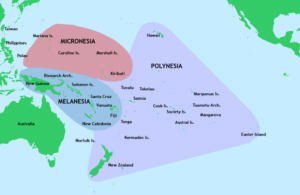
The surf riding roots
The surf riding discovery
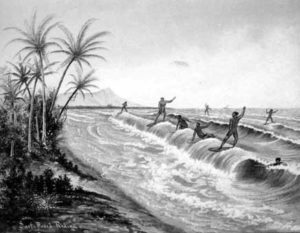
Courtesy Bishop Museum Archive
Courtesy Bishop Museum Archive
Surf-riding has been discovered in 1778 in Hawai’i when a British sailor named James Cook landed on the sandwich island.
He has been killed in a quarrel with the aboriginals just after his discovery.
Lieutenant James King took over the vessel and was the first to relate surfing activities in Kealakekua Bay that has been found in the logbook.
The colonialism era
Just after the Discovery, Hawai’i became the central Pacific destination of choice for captains, brigands, adventurers, missionaries, and other opportunists. The whites brought new technologies, languages, and Gods, along with vices and diseases. Surf-riding has been prohibited as the Polynesians were practicing naked, which was considered an act of depravity. From then on, Hawai’i and Hawaiian surfers wasted away for more than 150 years.
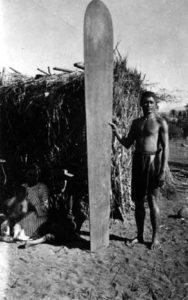
Courtesy bishop museum archive 1890
1st known photo of a surfer in 1890
In 1893, some of the 40 000 Hawaiians that remained tried to resist an illegal overthrow of the Hawaiian monarchy by a coalition of businessmen, plantation owners, and missionaries, assisted by U.S. Marines. The Hawaiians, led by Queen Lili’uokalani claim to maintain Hawai’i as a sovereign nation under Hawaiian control, but she’s been jailed. In 1898, the United States annexed Hawai’i as a territory.
The rebirth of surf
In the 1910s, a Native Hawaiian competition swimmer named Kahanamoku made this sport back. He qualified for the U.S. Olympic swimming team in 1912 at which he won a gold medal in the 100-meter freestyle and a silver medal with the second-place U.S. team in the men’s 4×200-meter freestyle relay. During the 1920 Olympics in Antwerp, he won gold medals both in the 100 meters and in the relay. He won his last medal during the 1924 Olympics in Paris.
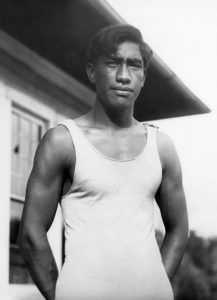
During his time living in Southern California, Kahanamoku performed in Hollywood as a background actor and a character actor in several films. In this way, he made connections with people who could further publicize the sport of surfing. Kahanamoku was involved with the Los Angeles Athletic Club, acting as a lifeguard and competing on both swimming and water polo teams.
While living in Newport Beach, California on June 14, 1925, Kahanamoku rescued 8 men from a fishing vessel that capsized in heavy surf while attempting to enter the city’s harbor. 29 fishermen went into the water and 17 perished. Using his surfboard, he was able to make quick trips back and forth to shore to increase the number of sailors rescued. Two other surfers saved four more fishermen. Newport’s police chief at the time called Duke’s efforts “the most superhuman surfboard rescue act the world has ever seen”. It also caused U.S. lifeguards to begin using surfboards in their water rescues.
The surf expansion
Thanks to Kahanamoku, surfing gained new energy. As surf riding was growing all around the world, in 1929, Lewis Rosenberg became the first person in the UK to be filmed catching a wave standing up.
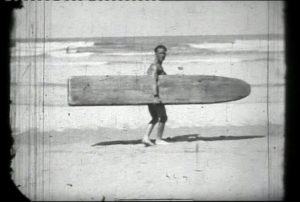
Lewis Rosenberg 1929
The surf post-war boom
After world war 2, surfing’s mecca moved from Hawai’i to Southern California, where new materials, design, and riding techniques were found. Longboards were made of fiberglass and polyurethane foam, showing a nose lift and stabilizing fins. On the riding side, it was the introduction of the bottom turns, cutbacks, and nose-riding.
![]()
The beginnings of a brand new surf industry took shape: do-it-yourself surf movies, surf shops, surf magazines, and Jack O’Neill introduced the first wetsuits. The surfing population during this time grow up from a few thousand to half a million whereas surfers, in general, were often viewed as a minor societal threat, like the bikers were.
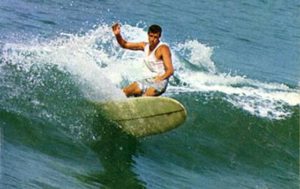
Nat Young 1966 World Championship Ocean Beach, San Diego
In the late 60s, the shortboard was introduced. The sport dove headlong into the counterculture. Surf competition, hugely popular during the boom years, was renounced as antithetical to what many were now calling the “art form” of surfing, then was somewhat rehabilitated in the mid-70s with the creation of the world professional circuit. It was the premises of surf stars like Gerry Lopez of Hawai’i for his 70s performances at the Pipeline.
Late 80’s – The surf second boom

Quiksilver, Gotcha and Billabong were among the surfwear companies that led the sport into a second boom, lasting from 1986 to 1990, imploding just about the time The Wall Street Journal announced surfing had become a billion-dollar-a-year industry.
90’s : Big wave surfing beginning
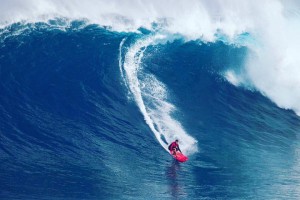
Big-wave riding moved to the fore in the early and mid-90s. Jet Ski-were introduced for riding waves higher than the conventional 35 feet limit for paddling. 65 feet waves were being ridden by the end of the decade.
2008 a surf legend is born

ASP World Tour. Billabong Pro, Mundaka, 29 Sept – 12 Oct 2008, Basque Country, Spain, Sopolana
Professional surfing continued to grow, and by the mid-2000s world tour events were being broadcast live on the Internet. In 2008, Kelly Slater of Florida was by far the world’s most successful pro, with 8 world titles and Layne Beachley from Australia capitalized on 7 championships. Guesswork always plays a big part in surfing demographics, but the global surfing population as of 2008, including bodyboarders and other “alternative craft” surfers, was evaluated to be about 5 million.
